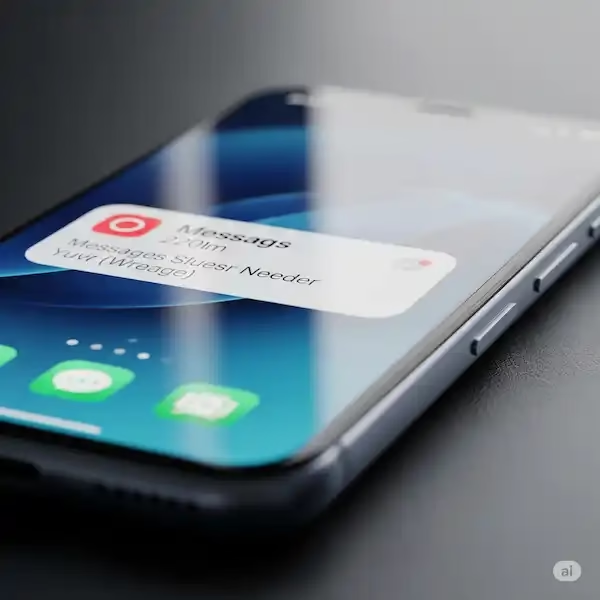Managing Notifications on iPhones and Android Phones
Tuning into the world through your phone means you’re constantly bombarded with updates. From urgent messages to social media buzz, notifications are the digital heartbeat of your smartphone. But what happens when that heartbeat becomes an overwhelming drum solo?
This article will help you master the art of notification management on both iPhones and Android phones, ensuring your device serves you, rather than the other way around.
Why Notifications Are Your Digital Sidekick
Notifications aren’t just annoying pop-ups; they’re essential tools that keep you in the loop and on top of your game.
- Stay in the Know: Get real-time updates from your favorite apps, so you’re always informed.
- Timely Alerts: Never miss an important meeting, breaking news, or a message from a loved one.
- Boost Your Productivity: Instant alerts mean you can respond faster and keep your workflow smooth.
- Emergency Preparedness: Crucial alerts, like weather warnings or safety notifications, can reach you instantly.
A Glimpse at the Notification Parade
Think of the variety of pings, vibrations, and banners you encounter daily. Here are just a few examples:
- Messages: That “ding” from a new text, a WhatsApp chat, or a direct message on social media.
- Social Media: Likes, comments, shares, and new posts from your friends and followers.
- Calendar Events: Gentle nudges reminding you of upcoming appointments or birthdays.
- News & Weather: Urgent alerts for breaking stories or sudden changes in local weather.
- App Updates: Reminders that an app needs an update to function optimally or gain new features.
- Location-Based Alerts: Your phone telling you about traffic on your commute or a store’s special offer as you walk by.
- Security Alerts: Important warnings about unusual activity on your accounts or system updates.
The Master Switch: Turning Notifications On or Off
Sometimes, you just need to silence an app completely. Here’s how to do it:
On iPhone (iOS)
- Open the Settings app.
- Tap on Notifications.
- Scroll down and select the app you want to manage.
- Toggle the “Allow Notifications” switch to the on or off position.
On Android
Toggle the switch next to the app name to turn its notifications on or off.
Open the Settings app.
Tap on Notifications (or sometimes “Apps & notifications,” then “Notifications”).
You might need to tap “App settings” or “See all apps” to find a full list.
Find and tap the app you want to manage.
Frequently Asked Questions (FAQ) about How to Manage Android Notifications:
Q: How do I turn on notifications for all of my apps?
A: Open the Settings app.
- Touch on Apps & notifications.
- Touch on Notifications.
- Toggle on the Allow notifications switch.
Video – How to Manage Android Notifications on Android phones and tablets?
How do I manage notifications for specific apps?
It’s great that you’re looking to get more granular control over your notifications! While simply turning notifications on or off for an app is a good start, both iPhones and Android phones offer much more in-depth customization for specific apps. This allows you to tailor your notification experience to be as precise as you need, ensuring you only get the alerts that truly matter.
Here’s how to manage notifications for specific apps:
Managing Notifications on iPhone (iOS)
On an iPhone, once you’ve gone to Settings > Notifications and selected a specific app, you’ll typically find a range of options:
- Allow Notifications: This is the master toggle. If it’s off, no notifications from the app will come through.
- Alerts: This section lets you choose where and how notifications appear:
- Lock Screen: Notifications appear on your iPhone’s lock screen.
- Notification Center: Notifications appear when you swipe down from the top of the screen (your consolidated notification hub).
- Banners: Notifications appear as a small banner at the top of your screen when your phone is unlocked and in use. You can often choose between:
- Temporary: The banner appears and disappears after a few seconds.
- Persistent: The banner stays on screen until you interact with it.
- Sounds:
- Toggle this on or off to enable or disable notification sounds for that specific app.
- For some Apple apps (like Messages, Mail, or Calendar), you can often choose a specific alert tone from a list.
- Badges:
- Toggle this on or off to control whether a red circle with a number appears on the app’s icon on your Home Screen, indicating unread notifications.
- Show Previews:
- This setting controls whether the content of the notification (e.g., the message text, calendar event details) is displayed. You can usually choose:
- Always: Previews are shown on the Lock Screen, in Notification Center, and banners.
- When Unlocked: Previews are only shown when your phone is unlocked.
- Never: No previews are shown; you’ll only see that you have a notification from that app.
- This setting controls whether the content of the notification (e.g., the message text, calendar event details) is displayed. You can usually choose:
- Notification Grouping:
- Automatic: iOS tries to intelligently group notifications.
- By App: All notifications from that app are grouped together.
- Off: Notifications are not grouped.
- Time Sensitive Notifications: (Introduced in iOS 15)
- For supported apps, these notifications will break through Focus modes and Do Not Disturb settings to ensure you receive urgent alerts (e.g., a security alert or an important medical reminder). You can toggle this on or off for each app.
To access these settings on iPhone:
- Open the Settings app.
- Tap Notifications.
- Scroll down and tap on the name of the specific app you want to manage.
- Adjust the options as desired.
Managing Notifications on Android
Android offers highly granular control over notifications, especially with “Notification Channels” (introduced in Android 8.0 Oreo). While the exact wording and location might vary slightly between Android versions and phone manufacturers (e.g., Samsung, Pixel, OnePlus), the core functionality is similar.
- Allow Notifications (Master Toggle): Similar to iPhone, this turns all notifications for the app on or off.
- Notification Categories/Channels: This is where Android truly shines. Many apps divide their notifications into different “categories” or “channels.” For example, a messaging app might have channels for:
- “New Messages”
- “Group Chat Notifications”
- “Promotional Messages”
- “App Updates” For each of these categories, you can often customize:
- Importance/Behavior: This dictates how intrusive the notification is. Common levels include:
- Urgent/Make Sound and Pop On Screen: (Highest priority) Notification makes a sound and appears as a “heads-up” notification (floating at the top of the screen).
- High/Make Sound: Notification makes a sound but doesn’t pop on screen.
- Medium/Silent and Minimize: Notification appears in the notification shade silently.
- Low/Silent: Notification appears in the notification shade silently, often at the bottom.
- Sound: Choose a specific sound for that category, or set it to silent. You can often choose from system sounds or even custom sound files.
- Vibration: Enable or disable vibration for that category.
- Badge: Control whether a notification dot/number appears on the app icon.
- Show on Lock Screen: Control whether the notification appears on the lock screen and with what level of detail (show content, hide content, don’t show).
- Override Do Not Disturb: Allow specific categories to bypass your Do Not Disturb settings.
- LED light (on supported devices): Control the color of the notification LED.
To access these settings on Android:
- Open the Settings app.
- Tap Notifications (or “Apps & notifications” > “Notifications” on some devices).
- Tap App settings or See all apps (the wording may vary).
- Select the specific app you want to manage.
- Look for options like Notifications, Notification categories, or Notification channels.
- Tap into individual categories to adjust their specific settings.
By diving into these app-specific notification settings, you can finely tune your smartphone to deliver alerts exactly how and when you want them, reducing distractions and ensuring you stay informed about what matters most to you.
- Open Settings, Scroll down looking for Notifications and Touch to open it.
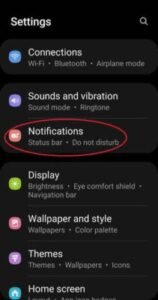
- On the Notification screen, Touch on App notifications to choose which apps are allowed to send you notifications.
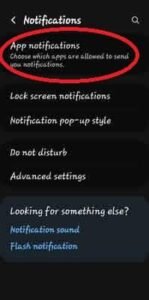
- You will see a list of the apps. It will initially show only the apps that Recently sent notifications. Touch on More to see more apps. To see all apps, Touch on Most recent and select All.

- Move the slider switch from left to right to turn off notifications for an app, or move from right to left to turn on notifications.
- To specify more detailed notifications for an app, Touch on the app to open the detailed list of notifications that that app offers. You can turn on or off specific notifications on this screen. For example, if you Touch on the Messenger app, the following detailed notifications will show:

- Touch and open In-app notification settings for even more specific control of notifications for the app.
How to see a History of Notifications so I can find a missed notifications?
You should enable or turn on the Notification History option to see all prior notifications.
- On the Notification screen, Touch on Advanced settings:
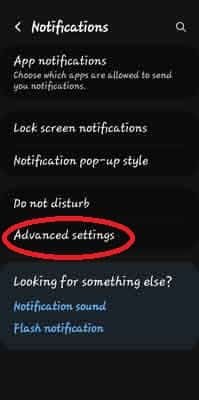
- On the Advanced settings screen, Touch on Notification history:
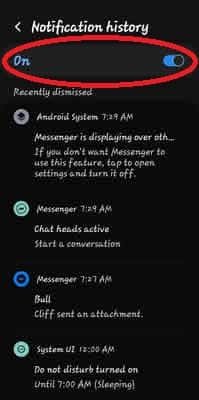
- Move the slider to the right to turn on notification history
How do I customize app notification sounds on Android?
You can also customize the notification sounds and type you receive for each app. For example, you can choose to receive only alerts for important notifications, or you can choose to receive all notifications.
- Open the Settings app.
- Touch on Apps & notifications.
- Touch on See all apps.
- Touch on the app you want to customize notification settings for.
- Touch on Notifications.
- Toggle on or off the different types of notifications you want to receive.
What are notification channels?
Notification channels allow you to group notifications by type, and then set different notification settings for each channel. For example, you could create a notification channel for social media apps, and then set those notifications to vibrate and pop up on your screen. You could create another notification channel for email, and then set those notifications to only vibrate.
How to use Do Not Disturb mode?
A: To use Do Not Disturb mode, go to Settings > Sound & vibration > Do Not Disturb. You can then choose to schedule Do Not Disturb to turn on and off automatically at certain times, or you can turn it on manually. How to use Do Not Disturb on Android?
How do I access the Notification Shade?
To access the Notification Shade, swipe down from the top of your screen. You can then touch on a notification to open the app, or you can swipe it away to dismiss it.
How do I manage notification channels?
To manage notification channels, go to Settings > Apps & notifications > Notifications > Notification channels. You can then view all of your notification channels and change their settings.
How do I clear all notifications?
To clear all notifications, swipe down from the top of your screen and touch on the Clear all button.
How do I stop an app from sending me notifications?
A: To stop an app from sending you notifications, go to Settings > Apps & notifications > See all apps and touch on the app you want to stop notifications for. Then, touch on Notifications and toggle off the Allow notifications switch.
How do I troubleshoot notification problems?
If you’re having problems with notifications, try the following:
- Restart your phone.
- Make sure that your phone is running the latest version of Android.
- Check to see if the app you’re having problems with has any updates available.
- Make sure that you have notifications enabled for the app.
- Check your notification settings and make sure that they’re configured the way you want them.
- If you’re still having problems, try contacting the app developer for assistance.
Here are some common problems and solutions for managing Android notifications:
Problem: Not receiving notifications for all of your apps.
Solution: Make sure that notifications are enabled for all of your apps. Go to Settings > Apps & notifications > Notifications and make sure that the Allow notifications switch is toggled on.
Problem: Receiving too many notifications.
Solution: You can customize the type of notifications you receive for each app. Go to Settings > Apps & notifications > See all apps and tap on the app you want to customize notification settings for. Then, tap on Notifications and toggle on or off the different types of notifications you want to receive.
Problem: Notifications not appearing on time.
Solution: Make sure that your phone’s clock is set correctly. You can also try restarting your phone.
Problem: Notifications not being dismissed when you swipe them away.
Solution: Make sure that your phone’s software is up to date. You can also try restarting your phone.
Problem: Notifications not appearing on the lock screen.
Solution: Make sure that notifications are enabled for the app on the lock screen. Go to Settings > Apps & notifications > See all apps and tap on the app you want to enable notifications for on the lock screen. Then, tap on Notifications > Lock screen and select Show.
Here are some tips for managing notifications on your Android phone:
- Use notification channels. Notification channels allow you to group notifications by type, and then set different notification settings for each channel. For example, you could create a notification channel for social media apps, and then set those notifications to vibrate and pop up on your screen. You could create another notification channel for email, and then set those notifications to only vibrate.
- Use Do Not Disturb mode. Do Not Disturb mode allows you to silence all notifications for a period of time, or until you turn it off. This can be useful if you’re trying to focus on something, or if you’re just trying to get some sleep.
- Use the Notification Shade. The Notification Shade is a list of all of your recent notifications. You can access the Notification Shade by swiping down from the top of your screen. You can then touch on a notification to open the app, or you can swipe it away to dismiss it.
- Clear all notifications or notifications from specific apps with a single tap.
- Uninstall apps that you’re not using to reduce the number of notifications you receive.
By following these tips, you can customize your notification settings to receive the information you need without being overwhelmed.
Additional helpful information:
Change the default notification sound on Android, How to change the notification sound on Android?
You can also change the notification sound on individual apps, How to change the notification sound for different apps?
To temporarily disable all notifications, Turn on Do Not Disturb on your phone.
